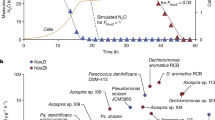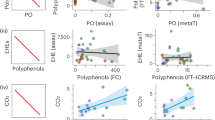Abstract
Neptunia amplexicaulis (Domin.) is a selenium-accumulating herbaceous legume endemic to Central Queensland. This species can accumulate selenium to more than 4,000 p.p.m. on a dry matter basis and is the main cause of clinical selenosis in livestock in some regions1. In previous work it was shown that 75Se-selenite is metabolized by this species predominantly into ethanol-soluble compounds, with negligible labelling of the protein fraction2. This distribution contrasted strongly with the predominant conversion of 75Se-selenite to seleno-amino-acids in peptide linkage in the proteins of several common pasture and cereal species2. The identity of the seleno-compounds present in N. amplexicaulis is therefore of considerable interest.
This is a preview of subscription content, access via your institution
Access options
Subscribe to this journal
Receive 51 print issues and online access
$199.00 per year
only $3.90 per issue
Buy this article
- Purchase on Springer Link
- Instant access to full article PDF
Prices may be subject to local taxes which are calculated during checkout
Similar content being viewed by others
References
McCray, C. W. R., and Hurwood, I. S., Queensland J. Agric. Sci., 20, 475 (1963).
Peterson, P. J., and Butler, G. W., Austral. J. Biol. Sci., 15, 126 (1962).
Hoagland, D. R., and Arnon, D. I., Calif. Agric. Exp. Sta. Circ., 347, 39 (1938).
Smith, I., Chromatographic and Electrophoretic Techniques, 1 and 2 (William Heinemann, London, 1960).
Peterson, P. J., and Butler, G. W., J. Chromatog., 8, 70 (1962).
Mozingo, R., Wolf, D. E., Harris, S. A., and Folkers, K., J. Amer. Chem. Soc., 65, 1013 (1943).
Shrift, A., and Virupaksha, T. K., Biochim. Biophys. Acta, 100, 65 (1965).
Kerdel-Vegas, F., Wagner, F., Russell, P. B., Grant, N. H., Alburn, H. E., Clark, D. E., and Miller, J. A., Nature, 205, 1186 (1965).
Gmelin, R., Strauss, G., and Hasenmaier, G., Z. Naturforsch., 13b, 252 (1958).
Gmelin, R., Z. f. Physiol. Chemie, 327, 186 (1962).
Horn, M. J., and Jones, D. B., J. Biol. Chem., 139, 649 (1941).
Virupaksha, T. K., and Shrift, A., Biochim. Biophys. Acta, 74, 791 (1963).
Trelease, S. F., Di Somma, A. A., and Jacobs, A. L., Science, 132, 3427 (1960).
Virupaksha, T. K., and Shrift, A., Biochim. Biophys. Acta, 107, 69 (1965).
Author information
Authors and Affiliations
Rights and permissions
About this article
Cite this article
PETERSON, P., BUTLER, G. Significance of Selenocystathionine in an Australian Selenium-accumulating Plant, Neptunia amplexicaulis. Nature 213, 599–600 (1967). https://doi.org/10.1038/213599a0
Published:
Issue Date:
DOI: https://doi.org/10.1038/213599a0
This article is cited by
-
Plant-soil relations of selenium, molybdenum and vanadium in the Richmond District of Central Queensland, Australia
Plant and Soil (2024)
-
Foraging for selenium: a comparison between hyperaccumulator and non-accumulator plant species
Scientific Reports (2023)
-
Root foraging and selenium uptake in the Australian hyperaccumulator Neptunia amplexicaulis and non‐accumulator Neptunia gracilis
Plant and Soil (2021)
-
The role of biomarkers in environmental assessment (4). Terrestrial plants
Ecotoxicology (1994)
Comments
By submitting a comment you agree to abide by our Terms and Community Guidelines. If you find something abusive or that does not comply with our terms or guidelines please flag it as inappropriate.



